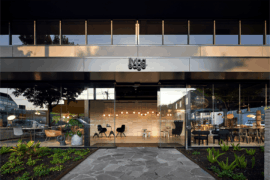It’s taken time, but the debate over the proposed re-development of the Perth Foreshore is now really fired up, writes Paul McGillick.
January 20th, 2012
Led by Dr Linley Lutton, the West Australian chairman of the Australian Institute of Urban Studies, a group calling themselves the City Gatekeepers is mobilising resistance and circulating a petition calling on the WA Government to review the proposal.
The conservative Barnett government inherited the scheme from the previous Labor government. The curious thing about it is that it began as one of those “Wouldn’t it be a good idea if…?” projects and, as critics are now pointing out, no one ever seems to have asked the crucial initial questions: Why do it and what outcomes do we want?

An important reason for the rapidly escalating opposition (a survey by the West Australian newspaper currently shows 57% opposition) has been the way perfectly reasonable objections have been brushed aside and not put up for public discussion.
Local architects and planners, some of whom have put forward alternative schemes, have until now been hesitant to come out publicly for fear of reprisals. It seems their fears may have some basis because backers of the scheme such as Professor Richard Weller (Director of the WA Urban Design Centre) and Sean Morrison (chairman of FuturePerth) have been quoted in the press slagging off the opposition rather than addressing the concerns.
Weller is quoted referring to “1970s claptrap” and Morrison to “a hodgepodge of people”.
Meanwhile, the Minister for Planning, John Day, has dismissed the concerns out of hand and said the scheme will go ahead, reinforcing the impression that from the beginning this is a scheme which developed its own momentum without any critical review of its objectives.
Yet there are very real concerns. An early justification of the scheme – a marina with mixed use high-rise towers on the edge of the Swan River – was that it would create connection between the CBD and the river. In fact, the over-scaled scheme looks like it will do the opposite.
Weller endorses the much-favoured developer justification for lucrative waterfront high-rise (we’re talking here of towers up to 36 storeys) by saying that the cost of effective foundations can only be paid for by high-rise. This is an absurdly circular proposition which only highlights the confused origins of the scheme.
The Gatekeepers have many other reservations including the fact that heritage-listed public domain is being sold off to private interests, that the proposed diversion of Riverside Drive (currently one of only two east-west bypasses around the CBD – the critics suggest putting part of Riverside Drive underground to obviate the current barrier) will cause traffic gridlock, environmental risks and the scale of the project including the timeframe which begins at 10 years.

While the likes of Weller and Morrison dismiss alternative proposals as “utterly suburban” and “lacking imagination and vision”, in fact it is the official scheme which is derivative and clichéd. Not for nothing was it initially dubbed “Dubai on the Swan”. Rather than a living, organic extension of the existing city centre, it will become just another party precinct decorated by souvenir shops.
There are many comparable waterside redevelopment schemes around the world and the overwhelming majority have placed public interest first, emphasised low- to medium-scale development, prioritised public space and amenity and ensured an organic connection with the existing city.
Like Barangaroo in Sydney, the real lack of vision lies in the way the public good is compromised by the meretricious argument that the effective development of the public domain can only be engineered by acceding to vested commercial and bureaucratic interests.

Paul McGillick is Editorial Director of Indesign. For more on the Perth foreshore development, see Sasha Ivanovich’s report in the upcoming Issue 49 of Indesign magazine.
INDESIGN is on instagram
Follow @indesignlive
A searchable and comprehensive guide for specifying leading products and their suppliers
Keep up to date with the latest and greatest from our industry BFF's!
The new range features slabs with warm, earthy palettes that lend a sense of organic luxury to every space.

A longstanding partnership turns a historic city into a hub for emerging talent

A curated exhibition in Frederiksstaden captures the spirit of Australian design

For Aidan Mawhinney, the secret ingredient to Living Edge’s success “comes down to people, product and place.” As the brand celebrates a significant 25-year milestone, it’s that commitment to authentic, sustainable design – and the people behind it all – that continues to anchor its legacy.

The Standard has opened in Singapore, offering sophisticated hotel and hospitality design amidst lush greenery in a serene pocket of the city.
The internet never sleeps! Here's the stuff you might have missed

Completed in 2025, Marella by Mosaic is a 30-storey residential tower in Broadbeach designed by Plus Studio. The project brings sculptural form, ocean views and hotel-style amenities together in a refined expression of coastal living.

With a date now set for January 2026, Sydney’s landmark project is taking shape as a significant and welcome addition to civic life in the city.